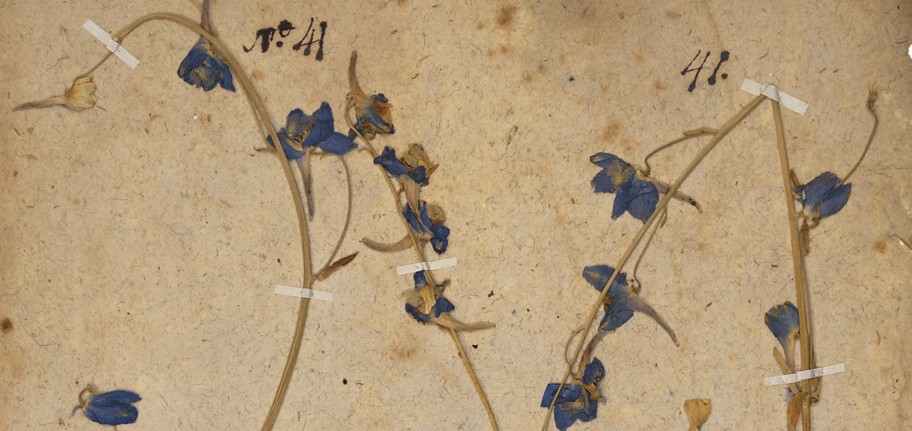Learning to see

After more than three centuries, specimens of Carolina larkspur, (Delphinium carolinianum Walter) still tell a story about their environment. In 1773, William Bartram, an American naturalist, began a four-year exploration of eight southern colonies, collecting flora as he traveled. Today, a team of researchers from Clemson and Furman University unveiled Bartram’s collection, along with those of several other naturalists, online. For more, see Treasures of Ecology.
Images from Bartram and Mark Catesby in this issue were photographed by Amy Hackney Blackwell, Patrick McMillan, and Christopher Blackwell in November of 2011 at the Sloane Herbarium of the Natural History Museum, London, in collaboration with Mark Spencer, curator. All images are licensed under a Creative Commons License.
When we decided to name this magazine Glimpse, we knew it would offer a peek at some things that are usually hidden from view. None of us can see, in the usual way, a film of carbon, only one atom thick, that could power the next generation of cars and devices and tools. Or the violence of stars exploding millions of years ago. Or the long-forgotten African slaves whose knowledge of indigo dye helped Eliza Lucas Pinckney build an industry around it.
So research helps us see. It supplies the specialized instruments and methods we use to penetrate the dark. And it teaches our scientists and students a very special kind of vision, an ability to recognize something of potential value, even when it is not what we expected to find.
Very often, that is what happens in the laboratory of Apparao Rao. His team looks for one thing and discovers another—an unintended shape that proves useful as a tiny sensor, for instance, or a “defect” that improves the flow of ions in batteries. No one can plan for such breakthroughs. They happen by accident. But if we blend the right talents and tools, the breakthroughs will come. And those breakthroughs will sometimes mature into companies, products, and jobs.
In a time when our economy is struggling to regain its momentum, we are tempted to promise too much from research. It would be nice if our faculty cranked out inventions on cue and according to plan. But that is not how research works. Christian de Duve, the 1974 Nobel Prize winner who helped unlock the mysteries of the cell, freely acknowledged that his own discoveries were largely accidental. We venture into the unknown, he said, and prepare ourselves to learn. The great appeal of science, he said, is the unknown.
At sixteen years old, when she first began to experiment with indigo on patches of high ground between rice fields, Eliza Lucas faced a vast unknown. Left by her father to manage his plantations in a wild and exotic new land, she had no way of knowing that her experiments would, in her lifetime, help create a powerful commercial enterprise that would build wealth on both sides of the Atlantic. But she was curious about botany, and the wizardry of making dye, and she had the good sense to learn from the people around her, even though they did not look like her.
Today more than ever we need that kind of brave curiosity, that willingness to venture out into a vast unknown. Somewhere out there in the dark is a breakthrough, a missing piece of knowledge that could help us to build something of value, solve a costly problem, protect our health or our environment, or treat a disease. We will not always know exactly what we are trying to find. But we will know it when we see it.
R. Larry Dooley
Interim Vice President for Research


